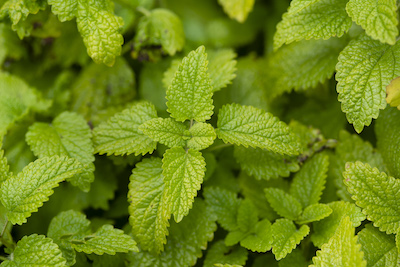Plant Profile: Lovely Lemon Balm
As your eyes drift across the garden, you might not immediately notice the bushy herb with the jagged-edged leaves. It’s easy to overlook amongst the sunflowers and the summer squash and the snapdragons.
But let’s take a closer look at this unobtrusive and unassuming herb. It’s sometimes called common balm, garden balm, balm mint, dropsy plant, honey plant, Melissa, sweet balm or heart’s delight—but it’s usually known as lemon balm.
It may not have achieved the fame of those herbal staples basil and mint, but lemon balm might surprise you with its versatility and its long history. Shakespeare mentioned it in The Merry Wives of Windsor and Homer referred to it in The Odyssey.

A Superlative Herb
Lemon balm (Melissa officinalis) is native to Europe, but over the centuries it has naturalized widely across the globe. Its presence in North America is said to date back to Colonial times, and by the 1820s, lemon balm seeds were regularly advertised in newspapers along with other herbs and plants.
Fast forward about 200 years. In 2007, the International Herb Association honored it as its Herb of the Year, a designation that recognizes superlative herbs that are “outstanding in at least two of the three major categories: medicinal, culinary or decorative.” Lemon balm amply meets the criteria.
A closer look at its botanical name reveals more: Melissa is Greek for honey bee, while officinalis is a Latin word related to medicine. This is a bushy and compact plant that reaches approximately 2 feet tall and wide and produces delicate pale flowers that bees adore. But don’t confuse it with bee balm! Bees love both plants and both are “balms,” however, lemon balm is completely distinct from bee balm (Monarda didyma).
It is a member of the mint family, and it shares mint’s tendency to take over the garden, although unlike mint, lemon balm spreads mostly by seed.
Easy to Grow
Easy to grow (after all, it’s a mint!), it isn’t particularly picky about its situation and can do well in full sun or part sun, in well-drained soil or soil that’s slightly moist, in garden beds or in containers. It’s even possible to grow it indoors although it isn’t considered ideal.
But the good attributes don’t stop there: lemon balm is also relatively free from pests and diseases. Animals generally avoid it, so you don’t have to worry about deer decimating your lemon balm plants.
Powdery mildew can be an issue (unless you choose a cultivar that has some resistance), but you can help prevent the disease by providing good airflow around plants. Allow generous spacing between plants and don’t be afraid to thin your lemon balm by harvesting stems to allow more air to circulate.
You can establish this herb by seed, by division, or by stem cuttings. It’s generally hardy to USDA zone 4—it overwintered in my zone 4a garden and came back beautifully in the spring.
There are lots of opinions about the best time to harvest it for peak flavor, so you may want to experiment to find the sweet spot. You can harvest throughout the summer. If you don’t want it to spread, trim back the plant before it goes to seed.
Lemon balm is often used fresh, but if you want to preserve it, just hang it upside down in small bunches to dry. You can also freeze it in vegetable oil or water.
Aromatherapy and Other Uses
One of the best ways to use lemon balm is to simply crush the leaves with your fingers and smell the glorious lemon scent. But it’s also wonderful in cooking, baking and beverages.
Lemon balm is probably best known for its use in teas. It can be delicious in iced or hot tea, punch and juice. You can also make lemon balm syrups that are then used in baked goods or beverages.
How about ice cream? Salad dressings? Cake? Lemon balm can be chopped fresh and added to an array of sweet and savory recipes from salads and soups to butter and bread. It’s delicious when used in poultry recipes and also pairs well with fish. And you can even make candied flowers from the blossoms—how delicately delightful!
Lemon balm is useful outside the kitchen, too. You can use lemon balm to make your own insect repellant, thanks to the high concentration of citronellal in the plant. Or crumble fresh leaves between your fingers to ward off unwelcome insects.
Lemon balm can be infused in cosmetics, like lip balm, and it also makes an excellent addition to a batch of potpourri.
Now, when it comes to medicinal uses, this herb has a long list of areas in which it has shown benefit, either anecdotally or in studies. Lemon balm is said to have some effect at relieving stress, anxiety, headaches, nausea, indigestion, cold sores and insomnia, as well as some positive effect on cognitive function. There has also been some indication that it may reduce agitation in Alzheimer’s patients. (Note: Consult your doctor before using herbs medicinally. Although considered to be a safe herb, it is not without the potential for side effects.)
Are you ready to experience the wonder that lemon balm can bring to your garden? This charming, lemon-scented plant is ready to take its place alongside your other favorite herbs!
This article by Samantha Johnson originally appeared in the September/October 2020 issue of Northern Gardener. She is the author of several books, including Garden DIY, (CompanionHouse Books, 2020). Visit her online portfolio at http://samanthajohnson.contently.com.
